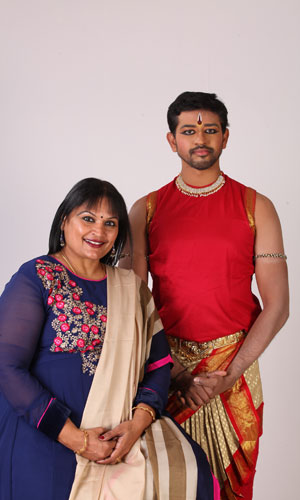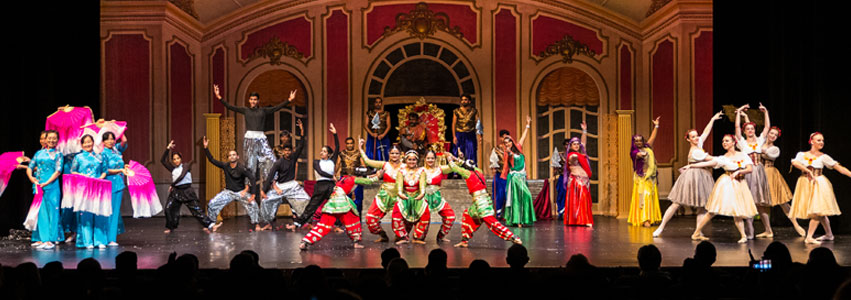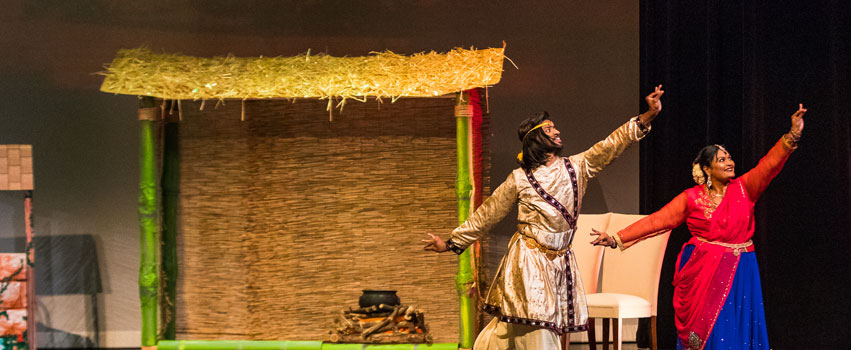Mythili Dance Academy shares the divine art of Bharatanatyam with the community.
Rama Suresh was only five years old in Chennai, India, when she began training in the ancient Indian dance style of Bharatanatyam. Encouraged by her mother, Mythili Rajappan, Suresh performed her arangetram—a dancer’s debut as a professional—at age nine. Under the tutelage of her gurus, who were grand masters themselves, she went on to become an acclaimed soloist, performing in various countries and attaining the prestigious title of Natya Mani, or “the dancer.”
Fortunately for the Peoria community, when she moved to central Illinois 30 years ago, Rama Suresh brought her passion and talent for Bharatanatyam with her. Through Mythili Dance Academy, named in honor of her mother, the founder and artistic director continues the centuries-old tradition of passing on this divine art to the next generation.
 What Is Bharatanatyam?
What Is Bharatanatyam?
Bharatanatyam is a classical Indian dance form dating back some 3,000 years to the southern part of India. From its origins as a dance used by royal courtesans in temple rituals, it has evolved into a form accessible to all. In the early 19th century, the structure and repertoire of Bharatanatyam dance was developed into the form we see it take today. More recently, in the 1930s, Bharatanatyam experienced a resurgence as part of a larger revival of interest in India’s cultural heritage that was taking place throughout the country. While the dance form no longer relied on royal patronage, its spiritual and devotional aspects remained.
According to the sacred Hindu text the Bhagavad Gita, Bharatanatyam dance can be a path to salvation. “Dance is an offering to God,” Suresh explains. “You can’t do a good job of doing this dance if you’re not spiritual. It doesn’t have to be any particular god… just the Supreme in general. It has to come from within.”
There are three key elements to the Bharatanatyam style. The first is known as nritta, which showcases the dancer’s command of rhythm. The second, nritya, are the facial expressions used by dancers during a performance, including the eyes—a feature unique to this form of dance. Finally, there is natya, the dramatic element that tells a story to the audience. The choreography of any dance in the Bharatanatyam repertoire will include all three elements.
Bharatanatyam does offer some similarities to ballet that a Western audience might notice. It is structured, with specific postures and poses that require exact attention to the way one angles the hands, feet and even eyes. It’s the presentation of these structured movements that distinguishes Bharatanatyam from other classical forms of dance.
Bharatanatyam dance is typically set to classical Indian music, and while its origins and history clearly tie it to Indian culture, Suresh assures that Bharatanatyam holds universal appeal. Its rhythmic aspects might be compared to Irish dancing, she notes, because of the many complex patterns the dancer must learn. The connection between the dancer and the audience is also integral to a Bharatanatyam performance. The dancer should always aim “to take the audience through the same emotions that you’re feeling,” Suresh says. “They have to feel it with you. When you’re happy, they have to be happy; when you’re sad, they have to feel sad.”

Prasanna Jeer is another talented dancer and choreographer in the Peoria area, whose styles include Bollywood, hip-hop and Bharatanatyam. The latter, he explains, requires a dancer to “use your face, your eyes, your whole body to emote different characters.” In fact, one dancer might embody 40 or 50 different characters in a single Bharatanatyam performance—and they must switch back and forth between personas with ease. In his own arangetram, for example, Jeer took on the parts of 50 characters—including a bird, monkey, king and queen.
Finally, a Bharatanatyam performance may last up to two and a half hours, making it an athletic as well as artistic feat. The most important thing for the Bharatanatyam dancer, Jeer attests, is what you discover about yourself as you embody so many different emotions and characters. Performing in this way, he says, can be a transformative and even cathartic experience.
Bharatanatyam in Peoria
At Mythili Dance Academy, Rama Suresh teaches the classical Bharatanatyam style of dance to students young and old. Many area parents send their children there to help connect their American-born kids to Indian culture. Bharatanatyam is also useful for teaching qualities like discipline, perseverance and patience, which can be used outside of a performance. Studying classical dance can teach you not only about the art form, but about life itself.
As a teacher, Suresh is extremely committed to her students. When she began teaching, she realized “you have to give part of your mind” to them. “I don’t think I’d be who I am today,” she adds, without some of the brilliant students she has had over the years.
When she founded the academy 30 years ago, the Indian community in Peoria was much smaller than it is today. Her biggest objective was simply to give back to the art form that she loved. As the years went on, Mythili Dance Academy also became a vehicle for Suresh to give back to the Peoria community. She credits her father for encouraging her to use her passion and talent for Bharatanatyam to help raise money for various charitable causes.
In the back of her mind, Suresh had always wondered what Bharatnatyam dance would look like alongside classical ballet. In 2014, she began an initial collaboration with the Peoria Ballet to create a show that fused the two classical styles to raise money for the Congenital Heart Center at OSF Children’s Hospital of Illinois. Shakunthala – The Forgotten Ring garnered around $50,000—a sizeable sum for the center. For Suresh, it was the beginning of a new tradition and a massive undertaking: creating stunning and ambitious performances to benefit the community.

In 2016, her vision of different cultures and artists coming together to make a difference grew even larger. Mythili Dance Academy partnered with OSF again for In The Shadow of the Swan, billed as a Cinderella story with a twist, again featuring dancers from the Peoria Ballet, as well as Chinese and Middle Eastern dancers. Prasanna Jeer, who had danced in The Forgotten Ring, became assistant director for this show, in addition to helping Suresh with choreography. In The Shadow of the Swan was so successful that the group traveled to Dallas, Texas to stage a follow-up performance.
For the shows she creates, Suresh generally adapts a story from a classic Indian fairy tale. “No one knows about the fairy tales we have in India,” she notes, “and they always have a beautiful twist to them.” Directing, choreographing and producing these performances is an enormous task. Both Suresh and Jeer attest to the months and months of work leading up to the performances—including long rehearsals, making costumes, selling tickets and all of the intricate details involved in putting on such a massive undertaking.
Last October, Suresh and Jeer produced their biggest show yet: a “mega dance musical” entitled Tale of The Anklets. For this production, they partnered with the Caterpillar Asian Indian Community and Central Illinois Ballet, with proceeds benefiting the Center for Prevention of Abuse. Choreographed by and starring Suresh and Jeer, Tale of The Anklets showcased a fusion of dance forms including Bharatanatyam, ballet, Chinese and Mediterranean dance.
Featuring more than 120 dancers, the colorful extravaganza celebrated the diversity of the Peoria community, the art of dance and storytelling, and community collaboration and fundraising—all to raise crucial funds to help survivors of abuse. It was another timeless and transcendent performance, offering a peek at the divine art as it takes shape in central Illinois. a&s
Learn more about Mythili Dance Academy at nritya1.wixsite.com/mythilidance-academy or find them on Facebook.


